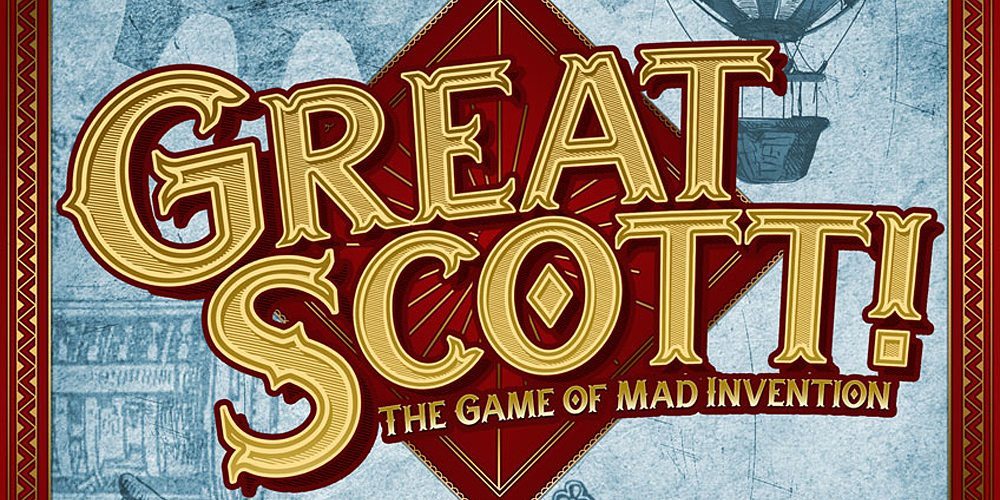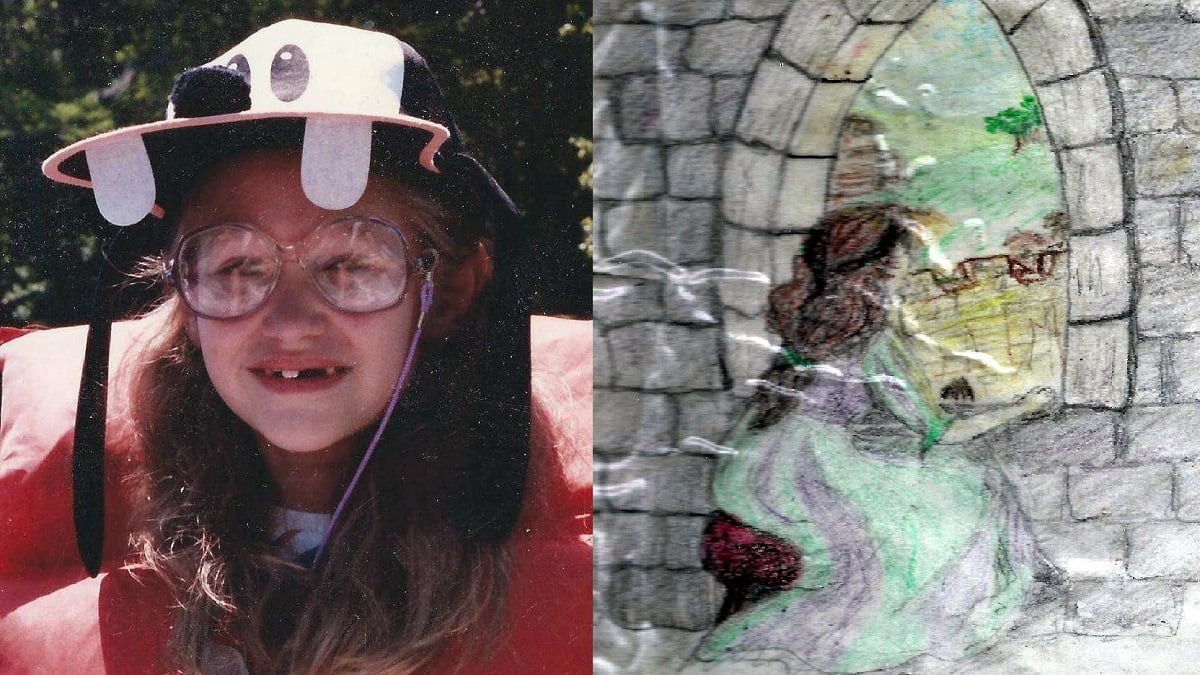
Great Scott! The Game of Mad Invention, is a card game in which you play as inventors during the reign of Queen Victoria, competing to create brilliant inventions and claim the title of Royal Inventor. The game was originally funded on Kickstarter in 2016 and shipped to backers in December. It is now available in stores and on Amazon.
Note: This review recaps some of my original Kickstarter Tabletop Alert.
At a Glance:
In Great Scott!, players use cards to build their inventions, choosing a card from their hand then passing that hand around the table. At the end of each round, each player will have a five-card creation in front of them which they must then explain to their fellow players. The age recommendation is for players aged 11 and up, but I have successfully played with children aged from seven who have enjoyed the game.
Components:
- 60 Asset Cards: 20 each of Animal, Mineral, and Vegetable
- 90 Concept Cards: 30 each of Productive, Destructive, and Transportive and divided into three decks (Primary, Central, and Final)
- 30 Commendation Cards: 15 one-point silver cards, and 15 two-point gold cards
- 5 Player Aid Cards
- Rule Book

The cards all have a steampunk/Victorian aesthetic, helped along by the artwork which was taken from genuine 19th-century illustrations made available by the British Library. The box matches this theme and is easily one of the prettiest I own, although the glowing green company logo on the sides does detract from the design a little. At just 5 x 7 x 2.5 inches it doesn’t take up too much room either, which is always a bonus for me. However, there does feel like there’s a lot of empty space in the box–I can easily pack the entire game into just one side. Hopefully, we will see some expansions in the future to help fill up that space.
How to Play:
Great Scott! is played over three rounds. During each round, players put together an invention consisting of five cards in the following order:
Primary Concept :: Asset :: Central Concept :: Asset :: Final Concept
Cards can be placed into the invention in any order, but the final invention must use this same pattern each time.

Each card has a name, points value from one to three, type, and either an illustration or a position symbol depending on whether they are asset or concept cards respectively.
To begin a game, all the asset and concept cards are placed into five face-down piles in the middle of the table, one pile for each card type with the assets split into two. Each player takes an aid card and six commendation cards (three of both types), then draws up a hand of ten cards by taking two from each pile on the table. The game is now ready to begin.
Each of the three rounds is made up of three stages. Stage one is played over five turns. During a turn, every player draws one card from any of the five piles on the table, thus taking their hand up to 11 cards. They each select a single card from their hand and play it face down on the table in front of them. Once every player has chosen a card, all players reveal their cards together. These cards are then left face up in front of the player and the players pass their remaining hand of ten cards to the player on their left, then a new turn begins. After five turns, all players will have a five-card invention on the table in front of them, and the game proceeds to the second stage of the round–presentations.

During the presentations stage, each player explains their invention to the other players, telling them what it does, how it works, how it came to be invented, or anything else they care to elaborate on. Once all the players have presented their inventions, each player chooses their first and second favorite (excluding their own) and hands those players face-down commendation cards worth either one or two points. These cards are not looked at yet, and players who receive them place them to the side until the end of the game.
Finally, the round moves to the third stage–scoring. Each invention is scored over a number of criteria.
- The value of the points on all five cards are added together.
- If both asset cards are of a matching type (either animal, vegetable, or mineral–indicated by symbol and border color), two points are added.
- If two of the three concept cards are of the same type (either productive, destructive, or transportive–again indicated by symbol and border color), two points are added. If all three concept cards are of the same type then four bonus points are added.
- Points are added for consecutive alliterative cards–that is, card names beginning with the same letter. Two points are awarded for a pair, four points for a trio, six points for a quad, and eight points for all five words in the invention. All the cards begin with the letters A through E which makes gaining these points a little easier.

In the example above, an invention created by my seven-year-old, the scoring goes as follows:
- Points from card values = 6 (2+1+1+1+1)
- Assets do not match (one animal and one vegetable) = 0
- Two matching concepts (bi-directional and elevator are both transportive cards) = 2
- Two consecutive alliterative cards (bi-directional bird) = 2
Therefore, this invention scores a total of 10 points.
It is impossible to maximize every scoring area in a single invention. For example, each type of asset card contains five cards which are worth the maximum three points, however, each one begins with a different letter. Therefore it is possible to play two asset cards of the same type that are worth three points each, OR to play two asset cards of the same type that begin with the same letter, but it is not possible to play two asset cards of the same type that are both worth three points AND that begin with the same letter.
Once the round is scored, the inventions are cleared away and a new round begins. In total, three rounds are played so each player will create three different inventions over the course of a game. Once the third and final round is scored, players turn over the commendation cards they have received throughout the game and add these points to their total. The inventor with the most points is then declared the winner and takes the title of Royal Inventor. In the case of a tie, the player with the most commendation points is the winner, and if there is still a tie after that, the player with the oldest cell phone wins.
Verdict:

We have had a lot of fun with this game. Despite being recommended for age 11 plus, my seven-year-old son has embraced it wholeheartedly, often laughing himself silly at his inventions such as the Bi-Directional Bird Altering Breadfruit Elevator. I assure you that little comes close to the hilarity factor of listening to a seven-year-old explain that one to you.
I recently took the game along when my son and I visited my sister and her family. A group of us played the game with my sister and her partner playing solo, my eight and fourteen-year-old nieces joining together as a team, and my son playing with me. This balanced out very well, and my nieces were thrilled to beat both of their parents by a handful of points.
Naturally, the younger players needed some help with some of the cards, but then the adults had to look up more than a few themselves. I myself had to quickly Google “bituminising” when my son asked what it meant. This did mean that the early turns were more drawn out with many players on their phones looking things up. My eldest niece suggested that it would have been useful to have a simple definition printed onto the cards to avoid this and I find myself agreeing with her. By including simple definitions, players may well be more likely to use these words rather than skipping over them each time to something they already know, thus expanding their vocabularies. See? This game is educational too!
My sister also pointed out that the mineral cards were almost never used by anyone, and I think I know why. In a game where making other players laugh is often a key strategy for gaining commendations, a Baboon Befuddler or a Cabbage Conqueror is always going to win over an Edenite Engine or a Diaboleite Defenestrator when most people probably don’t know what diaboleite or edenite are. I feel that replacing these cards with a more everyday category such as clothing (boots, coat, dress) or insects (ant, butterfly, cockroach, etc) could really expand the game.
These issues aside, we all really enjoyed playing Great Scott!, even those of us who struggle with creativity and speaking out loud during games. There are enough cards to ensure that you are very unlikely to duplicate even parts of inventions very often, and despite the younger players having a few vocabulary issues, the whole family was able to play together. The game is beautifully designed and the choice to use genuine Victorian-era illustrations on the cards adds an extra level of authenticity and artistry. If you enjoy playing with words, steampunk, or even just Monty Python-esque humor, I recommend checking it out.
GeekMom received this item for review purposes.




I backed this on kickstarter and have been playing it with friends for the last few months. However we tweaked a couple of the rules… We play our cards face-up rather than revealing them at the end of the round. This means players aren’t all hunting for cards starting with the same letter so it’s less frustrating. It also helps build anticipation for the presentation stage.
Also, you can spend any commendation points you’ve been awarded in the previous round. 1 point lets you swap the order of your asset (2nd and 4th) cards and 2 points lets you replace any card you’ve already played with one in your hand. These points are deducted from your score at the end of the round.
Really Its very Interesting Article. Thanks by https://geekmom.com